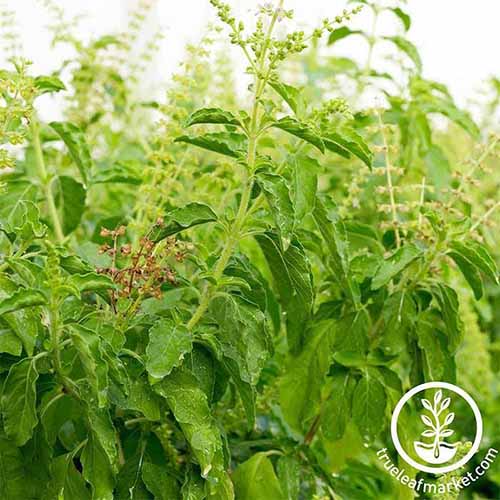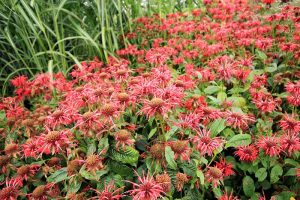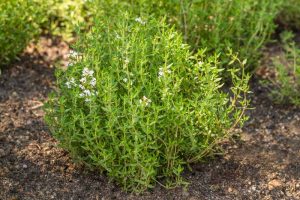Ocimum x citriodorum ‘Sweet Dani’
Basil is an herb garden staple. It’s easy to grow, and in exchange for minimal effort, you are rewarded with an abundant harvest of intensely flavorful leaves.
Practically every herb garden has a Thai or sweet variety in it. But if you’re looking for something just a bit different, consider the marvelous ‘Sweet Dani’ basil.
‘Sweet Dani’ is a lemon cultivar that is not just lemon scented and flavored, but incredibly so.
The citrus-forward flavor is stronger and slightly sweeter than that of other lemon varieties. It’s also more disease resistant and vigorous than other basils in general.

We link to vendors to help you find relevant products. If you buy from one of our links, we may earn a commission.
Whether your homegrown herbs are destined for tea, cocktails, pesto, or curry, this cultivar is totally worth having in the garden.
Coming up, we’ll cover everything you should know about ‘Sweet Dani,’ including:
What You’ll Learn
I can just about taste the lemony deliciousness already, so let’s not wait one second more!
Cultivation and History
‘Sweet Dani’ is a newer cultivar that was originally classified as a cultivar of sweet basil (Ocimum basilicum) with influences from lemon basil (O. × citriodorum), which is a hybrid of true basil and American basil (O. americanum).
But scientists working for the American Society for Horticultural Science did some genetic research and determined that ‘Sweet Dani’ should actually be considered a cultivar of lemon basil.

Why all the confusion? The story is actually pretty interesting.
It was bred in the 1980s at Purdue University by Mario Morales, a horticultural professor, and James E. Simon, a research professor at the university.
The pair were working on a project involving the essential oil of basils when they became interested in trying to find an excellent ornamental basil.
Rather than trying to breed specific plants with each other, the researchers put a bunch of different basils together and let them breed naturally.
Then, they went in and picked the best of the bunch, isolated them, and refined them further until they had stable characteristics.
‘Sweet Dani’ was the result of that experiment, and it hit the market in the mid-’90s.
The rest, as they say, is history.
‘Sweet Dani’ ended up proving to be a real winner. Extremely high in citral, which imparts that lemony scent and flavor, it has a distinct lemon flavor and scent. It also has good disease resistance.
This combination helped it to win the All American Selections Award in the vegetable category in 1998.
Named after Simon’s daughter Daniella, ‘Sweet Dani’ reaches up to 30 inches tall and is a vigorous grower. So long as you give it the right conditions, you’ll have an ample harvest. This herb has petite white flowers.
As with other basils, ‘Sweet Dani’ grows in USDA Hardiness Zones 4 through 9 as an annual, and Zones 10 and 11 as a short-lived perennial.
Propagation
‘Sweet Dani’ is simple to propagate. It reproduces well from seed, cuttings, and through division.
You can even divide those bushy container plants that you buy at the supermarket, if you can find this cultivar.
If you decide to start with seeds, you can plant them indoors in pots or trays. Move them outside when the low air temperatures are consistently above 60°F, and each seedling has at least four true leaves.
Be sure to harden your plants off when moving them outside, which involves adding an hour of outdoor exposure each day until they can stay outside full-time.
As you can tell, ‘Sweet Dani’ basil prefers warm soil, so if you buy transplants or divide a plant, be sure to wait to plant outside until the low air temperatures are above that 60°F mark.
Basil begins to mature quickly. You can go from planting seeds to moving things out into the garden in just a few weeks.
We have an entire guide dedicated to helping you propagate your basil plants if that’s something you’re interested in reading.
How to Grow
‘Sweet Dani’ is no different than its basil friends when it comes to growing requirements.
It prefers moist, well-draining, rich, loamy soil with a pH between 6.0 and 7.5. If your soil isn’t already perfect (and whose is?), try adding some well-rotted compost to the earth.
If you aren’t sure what type of soil you have, do a soil test.
Compost increases drainage and water retention, and works well to improve both clay and sandy soils.
All lemon basils prefer soil that stays consistently moist but not wet. The roots shouldn’t be submerged in standing water.
Imagine how a sponge feels when you wring it out well. That’s what the soil should feel like. Once it starts to feel drier, add water.
Plant in full sun. While you can grow this cultivar in part sun, the growth will be leggier and less compact in lower light conditions.
As with many herbs, this type lends itself particularly well to container growing, since it stays fairly small. Just be sure to keep the soil moist, as containers can dry out quickly.
Growing it in a dark container is a good way to raise the soil temperature a bit if you live somewhere cool, or want to get a head-start on the growing season.

This year, I have my ‘Sweet Dani’ growing in a pot with purple shiso perilla and Vietnamese coriander.
If you decide to grow yours indoors, put the pot near a south, east, or west facing window where it will receive at least five hours of sun per day.
If you can’t provide that, consider adding a grow light to your indoor herb garden setup.
Growing Tips
- Plant in well-draining, rich, loamy soil.
- Grow in full sun or partial shade.
- Wait until the soil is warm to plant outdoors.
Maintenance
Pinch off the flowers to ensure that you have a continual harvest of the leaves. Once the plant flowers, the leaves become less flavorful and tougher.
Pinching back also encourages bushier growth, which means more leaves for your cooking.
Because this cultivar grows so quickly, you need to keep a diligent eye out for flowering. ‘Sweet Dani’ starts flowering earlier than some other basils.
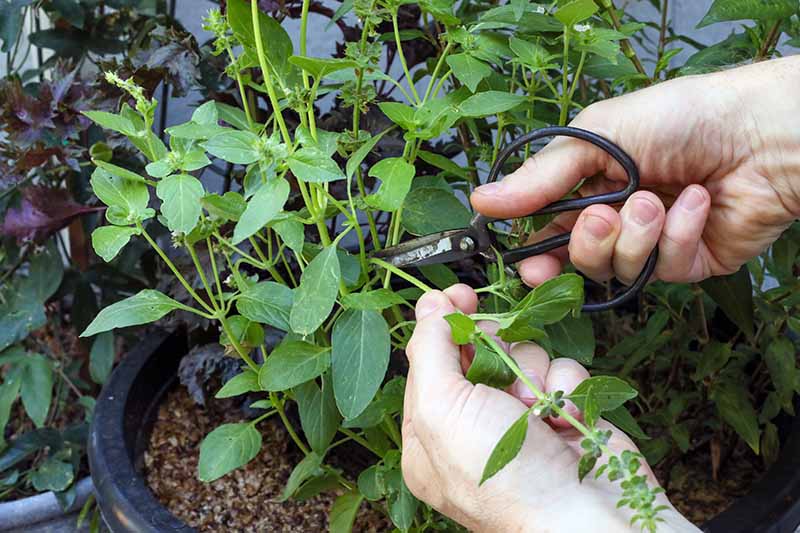
Instead of just pinching off the forming blossoms themselves, pinch the stem down by half when you pick or prune. That way, you’ll see tons of bushy new growth.
If you’re growing basil as a perennial, you can let it flower at the end of the growing season. Bees and butterflies love the blossoms.
If you want to save the seeds to propagate, you can clip the clusters off once the seeds have formed and the heads have turned brown.
Hang them to dry for a few weeks in a well-ventilated spot. Gently rub the dried seeds to separate them from the chaff and put them in an envelope. Store in a cool, dark spot and use them within two years.
Alternatively, leave the seeds in place. They will dry up and fall, and they might start new plants all by themselves.
Fortunately, basil isn’t one of those plants that becomes an out-of-control problem if you let it self-seed. Just pluck up any unwanted seedlings as needed when you spot them.
Keep in mind that different varieties of basil can cross-pollinate, and you might end up with a plant that doesn’t have the traits you expect. If you absolutely must have true ‘Sweet Dani’ in your garden, it’s safest to purchase seeds or starts from a reputable seller.
Also note that basil tends to lose its flavor as it ages. It’s better to start fresh than to try to keep the same plant growing year after year.
If you decide to keep it around for a second year, sample the young leaves in the spring and determine if you still like the flavor. If not, pull it and plant a new one.
These herbs rarely taste good after two years.
Where to Buy
You can often find seeds or starts available at your local garden center or nursery, and they are also available online.
True Leaf Market carries seeds in packets of 100, 1,000, and 5,000.
Managing Pests and Disease
‘Sweet Dani’ may suffer from the same diseases and pests that other basils do. Watch out for aphids, slugs and snails, Japanese beetles, and fungal diseases.

Read our guide to growing basil for more information on how to identify and control these fungal diseases and pests.
One added bonus is that ‘Sweet Dani’ is less susceptible to downy mildew than other basils. If other plants in your garden have struggled with this common disease, consider planting this gem.
Harvesting and Storage
Snip ‘Sweet Dani’ leaves as you need them. The more you cut and use the leaves, the more the plant produces and maintains a compact shape, so don’t be shy.
Of course, you should never completely defoliate a stem or it won’t be able to produce new growth. Try not to take more than half of the stem or leaves at a time.
Basil leaves are best plucked and used fresh as needed, but you can also dry or freeze them. We have more on that process in our Thai basil growing guide.
Recipes and Cooking Ideas
Lemon basil is indispensable in Laotian and Indonesian dishes such as curries, stir fries, and stews, and ‘Sweet Dani’ really shines in these recipes.
But while lemon basil has an herby, licorice-citrus flavor, ‘Sweet Dani’ has a sweeter, most distinctly lemony flavor.
That means not only can you use it wherever you’d typically use lemon basil, but it also lends itself particularly nicely to desserts.
Cheesecake with strips of the leaves used as a garnish, or creme brulee topped with ‘Sweet Dani,’ are both incredibly tasty treats.

Visit our sister site Foodal for an exceptional honey basil creamsicle recipe that you can make with your harvest if you’re craving a frozen treat.
It also makes a wonderful pesto, or a tasty addition to fruit salad.
Another of my favorite ways to use it is chopped up and sprinkled on top of elote antojitos, or Mexican street corn.
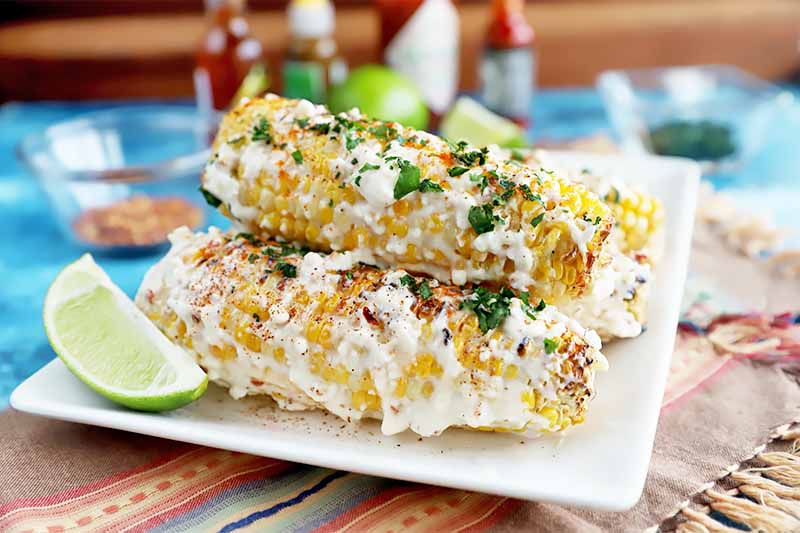
Find a recipe for this on Foodal as well.
In drinks, try using it as a lemonade garnish, or muddle it up with some sugar and rum for a summery mojito-style cocktail.
Quick Reference Growing Guide
| Plant Type: | Perennial herb, grown as an annual | Tolerance: | Moist soil |
| Native to: | Asia (India, Pakistan, Iran, Thailand) | Maintenance: | Low |
| Hardiness (USDA Zone): | 4-9 (annual), 10-11 (perennial) | Soil Type: | Rich, loamy |
| Season: | Summer | Soil pH: | 6.0-7.5 |
| Exposure: | Full sun | Soil Drainage: | Well-draining |
| Time to Maturity: | 60-70 days | Companion Planting: | Cilantro, chamomile, chives, marigolds, parsley, tomatoes |
| Spacing: | 12 inches | Avoid Planting With: | Bay, rosemary, rue, sage |
| Planting Depth: | 1/4 inch (seeds) | Family: | Lamiaceae |
| Height: | 30 inches | Genus: | Ocimum |
| Spread: | 12 inches | Species: | Basilicum |
| Water Needs: | Moderate | Variety: | Citriodorum |
| Common Pests and Disease: | Aphids, Japanese beetles, slugs, snails; damping off, fusarium wilt | Cultivar: | Sweet Dani |
‘Sweet Dani’ Is a Lemon Basil Standout
‘Sweet Dani’ is truly a standout. Between its intense lemony flavor, its disease resistance, and its vigorous growth, it’s clear why this one is an award winner.

Once you have yours going strong, come back and tell us about your favorite way to use up your harvest in the comments below.
I hope you got all the info you needed to plant, nurture, and use ‘Sweet Dani’ in this guide.
If so, we have some other helpful articles that will help you to grow delicious basil that you may want to check out next, starting with these:
